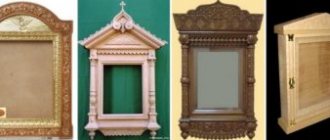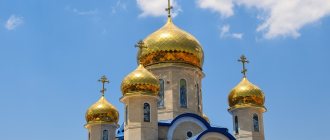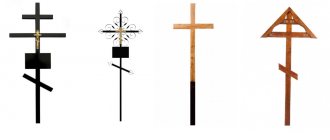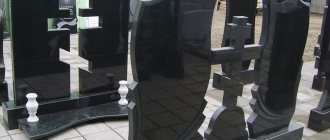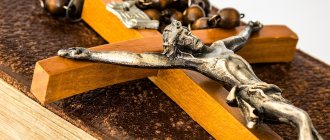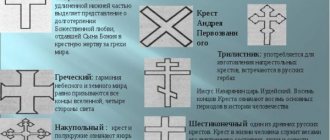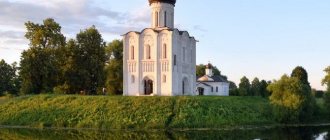The history of the Orthodox cross goes back many centuries. The types of Orthodox crosses are varied, each of them has its own symbolism. Crosses were intended not only to be worn on the body, but they are also used to crown the domes of churches, and crosses stand along the roads. Objects of art are painted with crosses, icon crosses are placed near icons at home, and special crosses are worn by clergy.
Crosses in Orthodoxy
But crosses in Orthodoxy had not only a traditional shape. Many different symbols and forms made up such an object of worship.
Orthodox cross shapes
The cross worn by believers is called a body cross. Priests wear a pectoral cross. They differ not only in size, there are many of their forms, each of which has its own specific meaning.
1) T-shaped cross. As you know, execution by crucifixion was invented by the Romans. However, in the southern and eastern parts of the Roman Empire, a slightly different cross was used for this purpose, namely the “Egyptian” cross, shaped like the letter “T”. This "T" is also found on 3rd-century tombs in the Callis catacombs and on one 2nd-century carnelian. If this letter was found in monograms, it was written in such a way as to protrude above all others, since it was considered not only a symbol, but also a clear image of the cross.
2) Egyptian cross "ankh". This cross was perceived as a key with the help of which the gates to Divine knowledge were opened. The symbol was associated with wisdom, and the circle with which this cross was crowned was associated with the eternal beginning. Thus, the cross combines two symbols - the symbol of life and eternity.
3) Letter cross. The first Christians used letter crosses so that their image would not scare off the pagans who were familiar with them. In addition, at that time, what was important was not so much the artistic side of the depiction of Christian symbols, but rather the convenience of their use.
4) Anchor-shaped cross. Initially, such an image of the cross was discovered by archaeologists in the Solunsk inscription of the 3rd century. The “Christian Symbolism” says that on the slabs in the caves of Pretextatus there were only images of an anchor. The image of an anchor referred to a certain church ship that sent everyone to the “quiet haven of eternal life.” Therefore, the cross-shaped anchor was considered by Christians to be a symbol of eternal existence - the Kingdom of Heaven. Although for Catholics this symbol rather means the strength of earthly affairs.
5) Monogram cross. It represents a monogram of the first letters of Jesus Christ in Greek. Archimandrite Gabriel wrote that the shape of a monogram cross crossed by a vertical line is the cover image of the cross.
6) Cross “shepherd’s staff”. This cross is a so-called Egyptian staff, which crosses the first letter of the name of Christ, which together is the monogram of the savior. At that time, the shape of the Egyptian staff resembled a shepherd's staff, its upper part was bent down.
7) Burgundy cross. This cross also represents the shape of the letter "X" of the Greek alphabet. It also has another name - Andreevsky. The letter "X" from the second century primarily served as the basis for monogamous symbols, because the name of Christ began with it. In addition, there is a legend that the Apostle Andrew was crucified on such a cross. At the beginning of the 18th century, Peter the Great, wishing to express the religious difference between Russia and the West, placed an image of this cross on the state emblem, as well as on the naval flag and his seal.
 The cross is the monogram of Constantine. Constantine's monogram was a combination of the letters "P" and "X". It is believed that it is associated with the word Christ. This cross has such a name, since a similar monogram was often found on the coins of Emperor Constantine.
The cross is the monogram of Constantine. Constantine's monogram was a combination of the letters "P" and "X". It is believed that it is associated with the word Christ. This cross has such a name, since a similar monogram was often found on the coins of Emperor Constantine.
9) Post-Constantine cross. Monogram of the letters "P" and "T". The Greek letter "P" or "rho" is the first letter in the word "raz" or "king" - symbolizing King Jesus. The letter "T" stands for "His cross." Thus, this monogram serves as a sign of the Cross of Christ.
10) Trident cross. Also a monogram cross. The trident has long symbolized the Kingdom of Heaven. Since the trident was previously used in fishing, the trident monogram of Christ itself meant participation in the Sacrament of Baptism as a catch in the net of the Kingdom of God.
11) Round cross. According to the testimony of Gortius and Martial, Christians cut freshly baked bread in a cross shape. This was done to make it easier to break later. But the symbolic transformation of such a cross came from the east long before Jesus Christ.
Such a cross divided the whole into parts, uniting those who used it. There was such a cross, divided into four parts or six. The circle itself was displayed even before the Nativity of Christ as a symbol of immortality and eternity.
12) Catacomb cross. The name of the cross comes from the fact that it was often found in the catacombs. It was a quadrangular cross with equal parts. This form of the cross and some of its forms are most often used in ancient ornaments that were used to decorate the guises of priests or temples.
11) Patriarchal cross. In the West, the name Lorensky is more common. Already from the middle of the last millennium, such a cross began to be used. It was this form of the cross that was depicted on the seal of the governor of the Byzantine emperor in the city of Korsun. The Museum of Ancient Russian Art named after Andrei Rublev houses just such a copper cross, which belonged to Abraham Rostvom in the 18th century and was cast according to samples of the 11th century.
12) Papal Cross. Most often, this form of cross is used in the bishop's services of the Roman Church of the 14th-15th centuries, and it is because of this that such a cross bears this name.
Who is the shamrock amulet suitable for?
In order to wear the triglav amulet, you need to have good intentions and use it only for good. Age and gender do not matter when using the amulet. It is suitable not only for an adult, but also for a child.
Thanks to his idea of worldly balance, he will impart calmness and positivity, and help you find the right path in life.
IMPORTANT! Not all Slavic amulets can be combined with Christian attributes. Triglav is one of those that should not interfere with Orthodox symbols. If you wear an amulet and a cross at the same time, this will lead to disastrous consequences.
The amulet is perfect for:
- people who love to travel. It will protect you on the road and give you inspiration;
- it will help creative people not to lose strength in themselves and will always give them inspiration to create something new;
- The amulet will help students find themselves in life and a thirst for knowledge, which will simplify the learning process;
- the amulet will show the way to those lost and despairing along the way;
- will protect people in dangerous professions from accidents;
- will help household members find harmony with each other, protect the house from evil forces and people;
- will bring good luck in business to people from the business sector;
- It will help people who practice magic to lift the veil of secrecy, strengthen intuition and strengthen magical power.
Types of crosses on church domes
The crosses that are placed on the domes of the church are called overhead crosses. Sometimes you can notice that straight or wavy lines emanate from the center of the upper cross. Symbolically, the lines convey the radiance of the sun. The sun is very important in human life, it is the main source of light and heat, life on our planet is impossible without it. The Savior is sometimes even called the Sun of Truth.
A famous expression says, “The light of Christ enlightens all.” The image of light is very important for Orthodox Christians, which is why Russian blacksmiths came up with such a symbol in the form of lines emanating from the center.
Small stars can often be seen along these lines. They are symbols of the queen of stars - the Star of Bethlehem. The same one who led the Magi to the birthplace of Jesus Christ. In addition, the star is a symbol of spiritual wisdom and purity. Stars were depicted on the Cross of the Lord so that it would “shine like a star in heaven.”
There is also a trefoil shape of the cross, as well as trefoil endings of its ends. But the branches of the cross were decorated not only with this image of leaves. A huge variety of flowers and heart-shaped leaves could be found. The trefoil can have either a round or pointed shape, or a triangle shape. The triangle and trefoil in Orthodoxy symbolize the Holy Trinity and are often found in temple inscriptions and inscriptions on tombstones.
Trefoil cross
The vine entwining the cross is a prototype of the Living Cross, and it is also a symbol of the Sacrament of Communion. Often depicted with a crescent at the bottom, which symbolizes the cup. Combined together, they remind believers that during Communion the bread and wine are transformed into the Body and Blood of Christ.
The Holy Spirit is depicted in the form of a dove on the cross. The dove is mentioned in the Old Testament; it returned to Noah's ark with an olive branch to announce peace to people. Ancient Christians depicted the human soul in the form of a dove, resting in peace. The dove, meaning the holy spirit, flew to Russian lands and landed on the golden domes of churches.
If you take a closer look at the openwork crosses on the domes of churches, you can see doves on many of them. For example, in Novgorod there is a church called the Myrrh-Bearing Women, on its dome you can see a beautiful dove woven “literally from thin air.” But most often the cast figurine of a dove is at the top of the cross. Even in ancient times, crosses with doves were quite a common occurrence; even three-dimensional cast figurines of doves with outstretched wings were found in Rus'.
Thriving crosses are those that have shoots growing from their base. They symbolize the rebirth of life - the resurrection of the cross from the dead. The Cross of the Lord in the Orthodox canon is sometimes called the “Life-Giving Garden.” You can also hear how the holy fathers call him “life-giving.” Some crosses are generously dotted with shoots that really resemble flowers in a spring garden. The interweaving of thin stems, an art made by masters, looks alive, and tasteful plant elements complete the incomparable picture.
The cross is also a symbol of the tree of eternal life. The cross is decorated with flowers, shoots from the core or from the lower crossbar, commemorating the leaves that are about to bloom. Very often such a cross crowns a dome.
In Russia it is almost impossible to find crosses with a crown of thorns. And in general, the image of Christ the martyr did not take root here, unlike in the West. Catholics often depict Christ hanging on the cross, with traces of blood and sores. It is customary for us to glorify his inner feat.
Therefore, in the Russian Orthodox tradition, crosses are often crowned with flower crowns. The crown of thorns was placed on the head of the Savior and was considered a healing for the soldiers who wove it. Thus, the crown of thorns becomes the crown of righteousness or the crown of glory.
At the top of the cross, although not often, there is a crown. Many believe that crowns were attached to temples related to holy persons, but this is not so. In fact, the crown was placed on the top of the cross of churches built by royal decree or with money from the royal treasury. Additionally, the Scriptures say that Jesus is the king of kings or lord of lords. Royal power, accordingly, is also from God, which is why the crosses contain a crown on their top. The cross topped with a crown is also sometimes called the Royal Cross or the Cross of the King of Heaven.
Sometimes the cross was depicted as a divine weapon. For example, its ends could have the shape of a spear tip. Also on the cross there could be a blade or its handle as a symbol of a sword. Such details symbolize the monk as a warrior of Christ. However, it can only act as an instrument of peace or salvation.
Meaning and interpretation of the Trefoil symbol
A trefoil is a cross, the ends of which consist of 3 semicircular leaves, sometimes with knobs. This form is most often used for making altar crosses.
Any cross symbolizes life, but in the trefoil the living principle is most pronounced. It was revered even in the pre-Christian period; the Druids worshiped it as a sacred plant that bestowed vitality. And even now, many, without thinking about the sacred meaning of this figure, consider it a sign of good luck to find a clover leaf.
The trefoil is a symbol of triads, on which the entire world order is based. In Slavic culture, the ideal completeness of the trefoil shape expressed the magical properties of the three: unity/harmony/perfection; past present Future; water/earth/air; husband/wife/child.
Each clover leaf was one of the sides of the Slavic world, the tree of life: Reveal, Rule and Navi.
Reality
The Slavs called reality the life mission of a person. In the real world, human souls acquired mortal bodies and obeyed the general world order.
In the schematic representation of the trinity of the world, Reality occupied the middle part - the tree trunk.
Nav
Nav occupied the farthest part of Trefoil, where the roots of the tree are located. This is the world of the dead, where the souls of deceased ancestors live. They directly influence the world of reality, communicating with their descendants through dreams.
Edit
In the diagram of the structure of the world, Prav is an equivalent leaf of the Trefoil, which is located at the top of the tree. This is the invisible world of the Gods who created the foundations of the Universe and gave people the rules by which they must live. Only the brightest and most decent souls of the Slavs had a chance to get into the world of Rule.
The most common types of crosses
1) Eight-pointed cross. This cross is the most consistent with historical truth. The cross acquired this shape after the crucifixion of the Lord Jesus Christ on it. Before the crucifixion, when the Savior carried the cross to Calvary on his shoulders, it had a four-pointed shape. The upper short crossbar, as well as the lower oblique, were made immediately after the crucifixion.
Eight-pointed cross
The lower oblique crossbar is called the footboard, or footstool. It was attached to the cross when it became clear to the soldiers where His feet would reach. The top crossbar was a tablet with an inscription, which was made by order of Pilate. To this day, this form is the most common in Orthodoxy; eight-pointed crosses are found on body crosses, they crown the domes of the church, and they are installed on tombstones.
Eight-pointed crosses were often used as the basis for other crosses, such as awards. During the era of the Russian Empire, during the reign of Paul I and before him, under Peter I and Elizaveta Petrovna, there was a practice of rewarding the clergy. Pectoral crosses were used as a reward, which was even formalized by law.
Paul used the Paul Cross for this purpose. It looked like this: on the front side there was an applied image of the Crucifixion. The cross itself was eight-pointed and had a chain, all made of gilded silver. The cross was issued for a long time - from its approval by Paul in 1797 until the revolution of 1917.
2) The practice of using crosses when awarding awards was used not only to present awards to clergy, but also to soldiers and officers. For example, the very well-known St. George Cross, approved by Catherine, was subsequently used for this purpose. The quadrangular cross is also reliable from a historical point of view.
In the Gospel it is called “His cross.” Such a cross, as has already been said, was carried by the Lord to Golgotha. In Rus' it was called Latin or Roman. The name comes from the historical fact that it was the Romans who introduced execution by crucifixion. In the West, such a cross is considered the most faithful and is more common than the eight-pointed one.
3) The “grapevine” cross has been known since ancient times; it was used to decorate the tombstones of Christians, utensils and liturgical books. Nowadays such a cross can often be purchased in a church. It is an eight-pointed cross with a crucifix, surrounded by a branchy vine that sprouts from below and is decorated with full-bodied tassels and leaves with a variety of patterns.
Cross "grapevine"
4) The petal-shaped cross is a subtype of the quadrangular cross. Its ends are made in the form of flower petals. This form is most often used in painting church buildings, decorating liturgical utensils, and in sacramental vestments. Petal crosses are found in the oldest Christian church in Rus' - in the Church of Hagia Sophia, the construction of which dates back to the 9th century. Pectoral crosses in the form of a petal cross are also common.
5) The trefoil cross is most often four-pointed or six-pointed. Its ends have a corresponding trefoil shape. Such a cross could often be found in the coats of arms of many cities of the Russian Empire.
6) Seven-pointed cross. This form of cross is found very often on icons of northern writing. Such messages mainly date back to the 15th century. It can also be found on the domes of Russian churches. Such a cross is a long vertical rod with one upper crossbar and an oblique pedestal.
On a golden pedestal, the clergy before the appearance of Jesus Christ made an atonement sacrifice - this is what it says in the Old Testament. The foot of such a cross is an important and integral element of the Old Testament altar, which symbolizes the redemption of God's anointed one. The foot of the seven-pointed cross contains one of its most sacred qualities. In the sayings of the messenger Isaiah the words of the Almighty are found: “Give praise to the footstool of My feet.”
7) Cross “crown of thorns”. Various peoples who converted to Christianity depicted a cross with a crown of thorns on many objects. On the pages of an ancient Armenian handwritten book, as well as on the 12th century “Glorification of the Cross” icon, which is located in the Tretyakov Gallery, such a cross can now be found on many other elements of art. Teren symbolizes thorny suffering and the thorny path that Jesus, the son of God, had to go through. A crown of thorns is often used to cover the head of Jesus when depicting him in paintings or icons.
Cross "crown of thorns"
 Gallows-shaped cross. This form of the cross is widely used in painting and decorating churches, priestly vestments and liturgical objects. On images, the ecumenical holy teacher John Chrysostom was often decorated with such a cross.
Gallows-shaped cross. This form of the cross is widely used in painting and decorating churches, priestly vestments and liturgical objects. On images, the ecumenical holy teacher John Chrysostom was often decorated with such a cross.
9) Korsun cross. Such a cross was called Greek, or Old Russian. According to church tradition, the cross was installed by Prince Vladimir after returning from Byzantium to the banks of the Dnieper. A similar cross is still kept in Kyiv in the St. Sophia Cathedral, and it is also carved on the tombstone of Prince Yaroslav, which is a marble plaque.
10) Maltese cross. This type of cross is also called the St. George cross. It is a cross of equal shape with widening sides towards the edge. This form of the cross was officially adopted by the Order of St. John of Jerusalem, which was formed on the island of Malta and openly fought against Freemasonry.
This order organized the murder of Pavel Petrovich, the Russian Emperor, ruler of the Maltese, and therefore has the appropriate name. Some provinces and cities had such a cross on their coats of arms. The same cross was a form of award for military courage, called the St. George cross and had 4 degrees.
11) Prosphora cross. It is somewhat similar to St. George's, but includes words written in Greek “IC. XP. NIKA" which means "Jesus Christ is the Victor." They were written in gold on three large crosses in Constantinople. According to ancient tradition, these words, together with a cross, are printed on prosphoras and mean the ransom of sinners from sinful captivity, and also symbolize the price of our redemption.
12) Wicker cross. Such a cross can have either equal sides or a longer lower side. Weaving came to the Slavs from Byzantium and was widely used in Rus' in ancient times. Most often, images of such crosses are found in Russian and Bulgarian ancient books.
13) Wedge-shaped cress. A widening cross with three field lilies at the end. Such field lilies are called “selnye krins” in Slavic. A cross with field lines from the 11th century Serenstvo can be seen in the book “Russian Copper Casting”. Such crosses were widespread both in Byzantium and later in the 14th-15th centuries in Rus'. They meant the following: “the heavenly Bridegroom, when he descends into the valley, becomes a lily.”
14) Drop-shaped four-pointed cross. The four-pointed cross has small drop-shaped circles at the ends. They symbolize the drops of Jesus' blood that sprinkled the tree of the cross during the crucifixion. The drop-shaped cross was depicted on the first page of the 2nd century Greek Gospel, which is in the State Public Library.
Often found among copper pectoral crosses, which were cast in the first centuries of the second millennium. They symbolize Christ's struggle to the point of blood. And they tell the martyrs that they must fight the enemy to the last.
15) Cross "Golgotha". Since the 11th century, under the lower oblique crossbar of the eight-pointed cross, an image of Adam buried on Golgotha appears. The inscriptions on the Calvary cross mean the following:
- "M. L.R.B. "-"the place of execution was quickly crucified", "G. G." - Mount Golgotha, "G. A." - head of Adamov.
- The letters "K" and "T" stand for a warrior's spear and a cane with a sponge, which is depicted along the cross. Above the middle crossbar: “IC”, “XC” - Jesus Christ. The inscriptions under this crossbar: “NIKA” - Winner; on the title or near it there is an inscription: “SN BZHIY” - Son of God. Sometimes "I. N. Ts. I" - Jesus of Nazareth, King of the Jews; inscription above the title: “TSR” “SLVY” - King of Glory.
Such a cross is depicted on a funeral shroud, signifying the preservation of the vows given at baptism. The sign of the cross, unlike the image, conveys its spiritual meaning and reflects the real meaning, but is not the cross itself.
16) Gammatic cross. The name of the cross comes from its similarity to the Greek letter “gamma”. This form of cross was often used in Byzantium to decorate Gospels and churches. The cross was embroidered on the vestments of church ministers and depicted on church utensils. The gammamatic cross has a shape similar to the ancient Indian swastika.
For the ancient Indians, such a symbol meant eternal existence or perfect bliss. This symbol is associated with the sun, it became widespread in the ancient culture of the Aryans, Iranians, and is found in Egypt and China. During the era of the spread of Christianity, such a symbol was widely known and revered in many areas of the Roman Empire.
The ancient pagan Slavs also widely used this symbol in their religious attributes. The swastika was depicted on rings and rings, as well as other jewelry. It symbolized fire or the sun. The Christian Church, which had powerful spiritual potential, was able to rethink and churchize many cultural traditions of antiquity. It is quite possible that the gammatic cross has just such an origin and that it entered Orthodox Christianity as an ecclesiastical swastika.
Triglav tattoo
A shamrock tattoo will have strong power due to close contact with the owner and will look impressive and mysterious.
But be careful - to wear such a tattoo, you need to be sure that it will not have a negative impact on you. Only if your thoughts are pure and you can call yourself a good person can you decide to draw a shamrock on your body.
To check how this magical symbol will affect you, you can get a temporary tattoo. A shamrock tattoo would be an ideal option if you want to strengthen your connection with your family, gain good luck and gain strength of spirit.
What kind of pectoral cross can an Orthodox Christian wear?
This question is one of the most frequently asked among believers. Indeed, this is quite an interesting topic, because with such a wide variety of possible species, it is difficult not to get confused. The basic rule to remember: Orthodox Christians wear a cross under their clothes; only priests have the right to wear a cross over their clothes.
Any cross must be consecrated by an Orthodox priest. It should not contain attributes that are related to other churches and do not apply to the Orthodox.
The most significant attributes are:
- If this is a cross with a crucifix, then there should be not three crosses, but four; both feet of the Savior can be pierced with one nail. Three nails belong to the Catholic tradition, but in the Orthodox there should be four.
- There used to be another distinguishing feature that is no longer supported. In the Orthodox tradition, the Savior would be depicted alive on the cross; in the Catholic tradition, his body was depicted hanging in his arms.
- A sign of an Orthodox cross is also considered to be an oblique crossbar - the foot of the cross with the right ends up, when looking at the cross in front of it. True, now the Russian Orthodox Church also uses crosses with a horizontal foot, which were previously found only in the West.
- Inscriptions on Orthodox crosses are made in Greek or Church Slavonic. Sometimes, but rarely, on the tablet above the savior you can find inscriptions in Hebrew, Latin or Greek.
- There are often widespread misconceptions regarding crosses. For example, it is believed that Orthodox Christians should not wear the Latin cross. The Latin cross is a cross without a crucifix or nails. However, this point of view is a delusion; the cross is not called Latin for the reason that it is common among Catholics, because the Latins crucified the Savior on it.
- The emblems and monograms of other churches must be absent from the Orthodox cross.
- Inverted cross. Provided there is no crucifix on it, historically it has always been considered the cross of St. Peter, who, at his own request, was crucified head down. This cross belongs to the Orthodox Church, but is now rare. The upper beam is larger than the lower one.
The traditional Russian Orthodox cross is an eight-pointed cross with an inscription on top, an oblique footplate at the bottom, and a six-pointed cross.
Contrary to popular belief, crosses can be given, found and worn; you can not wear a baptismal cross, but simply keep one. It is very important that any of them be consecrated in the church.
Appearance of the amulet
Despite the fact that the trefoil is called the triglav, it belongs to the god Veles. In the minds of people, an association with the mighty host of three gods Triglav has been fixed, although it is Veles who is the ruler of the three worlds.
The trefoil is the intersection of three petals with pointed ends, enclosed in a circle. They are drawn in a single line, with one petal pointing up and the other two looking down.
They symbolize three worlds: the real world, in which all people live - Reality, the heavenly one, where the gods live - Rule, and the underground world of Nav, in which dead souls rest.
The fact that the petals-worlds are intertwined with each other in one line and placed in a circle means the harmony of the three worlds.
INTERESTING TO KNOW! Thanks to the shamrock, a similar symbol has spread - a three-leaf clover enclosed in a circle. It was used in magical rituals and had enormous protective power.
Votive cross
In Rus' there was a custom to erect votive crosses in honor of memorable dates or holidays. Usually such events were associated with the death of a large number of people. It could be fires or famine, or a cold winter. Crosses could also be installed as gratitude for deliverance from any misfortune.
In the city of Mezen in the 18th century, 9 such crosses were installed, when during a very harsh winter, all the inhabitants of the city almost died. In the Novgorod principality, personalized votive crosses were installed. After that, the tradition passed to the northern Russian principalities.
Sometimes certain people would erect a votive cross to mark a specific event. Such crosses often bore the names of the people who created them. For example, in the Arkhangelsk region there is the village of Koinas, where there is a cross called Tatyanin. According to the residents of this village, the cross was installed by a fellow villager who made such a vow. When his wife Tatyana was overcome by illness, he decided to take her to a church that was located far away, since there were no other churches nearby, after which his wife recovered. It was then that this cross appeared.
How to use the amulet correctly
The Slavic Triglav requires careful attention. Remember that if you use the amulet incorrectly, you will turn all its power against you.
- It is forbidden to wear a shamrock made from parts of killed animals: fangs, bones, skin, claws, etc.;
- You cannot wear a Christian cross at the same time as an amulet;
- when using a pendant, you need to wear it on a metal, preferably silver, chain, or on a thread made from natural ingredients;
- You should not give the amulet to other people, because it will absorb someone else’s energy.
You will be interested: Znich - the meaning of the Slavic amulet, who is suitable for and how to use
After purchasing or making a triglav, you need to perform a purification ceremony. There are several ways to clean it.
- Rinse with spring or running water.
- Leave for three days in a cup with salt. It cannot be used on the farm after the ritual.
- Pass the amulet over the candle flame.
- Bury or place the amulet in the ground for a day.
- Sage or crushed cedar bark will cleanse the amulet with its aroma.
REMEMBER! You need to cleanse the amulet in a good mood so that the negative energy of bad thoughts does not absorb into it.
Russian Orthodox Church
The article by Metropolitan Vladimir of Omsk and Tauride was published in the November issue of the Journal of the Moscow Patriarchate (No. 11, 2022, PDF version).
***
Primate... Much is said with this one word. Primate is the one who stands in front, in front of the entire Church; The Primate is the one who receives the first honor among the hierarchs of the Local Church, but at the same time he is also the one at whom her enemies throw arrows most of all. Great is the ministry of the Primate, and great is the responsibility that rests on him.
Saint John Chrysostom likened the priest to the helmsman of a ship. With whom then can the First Hierarch be compared? With an admiral who leads the entire flotilla of the Church - all ships, small and large, high-speed and slow-moving. He stands on the first ship, going ahead of all, taking upon himself all the difficulties of this spiritual voyage and taking care of all the sailors on the remaining ships.
The very appointment of the Primate is an act of Divine Providence. At the same time, in the best sense of the word, it is a human matter, since it expresses the will and choice of archpastors, pastors, monastics and parishioners of the Church, who prayerfully turn to God for guidance in this important matter of electing their Primate and entrusting him with the care of the entire Church. completeness. This is the Theanthropic mystery of the Church of Christ, just as superior to earthly affairs as, in the words of St. John Chrysostom, the power of the priest rises above the power of the earthly ruler, the priesthood above the kingdom. However, in the history of our state, unfortunately, this was not always the case.
Liberation after 270 years of captivity
Exactly three hundred years ago, in 1721, the Patriarchate was abolished by the creation of the Theological College, which later received the name of the Holy Synod, and the publication of the Spiritual Regulations in Russia. Instead of the Patriarch, an advisory body was created in Russia, completely subordinate to the tsarist power and the imperial bureaucracy. It is difficult to underestimate the seriousness and catastrophic consequences of this event for Russia and the Church. For almost two centuries, the Russian Church was left without its Primate, whose role was transferred to a specially created state institution.
This synodal period essentially lasted much longer: elected to the Patriarchal throne in 1917, after the Bolsheviks came to power, Saint Tikhon also could not fully fulfill his ministry. Every step he took was met with opposition from the new government, which sought to impose an even harsher, more violent dictatorship on the Church than the one that had existed in the previous synodal bicentenary. And for more than seventy years, until the end of the 1980s, this captivity of the Church by an atheistic state continued, depriving the Patriarchate of the very opportunity to exercise full leadership of church life. Without the approval of the authorities, it was impossible to carry out a single episcopal consecration, not a single installation on the department, not a single convening of a Local Council; every action, every decision of the Patriarch was controlled by the authorities...
Fortunately, the Moscow primate throne during this most difficult period was occupied by outstanding hierarchs: Patriarchs Sergius, Alexy I, Pimen. Despite the difficult conditions in which they had to bear the burdens of patriarchal service, they did everything possible to preserve and save the Church, to navigate its ship among the raging waves of theomachism with the least losses. But their capabilities were extremely limited, their holy voices reached the flock with great difficulty through the blank walls of state atheism, their patriarchal leadership was constantly challenged by various government officials who considered themselves entitled to manage the affairs of the Church. It can be said that only the last thirty years, since the beginning of the 1990s, after the veil of atheism had finally fallen from the eyes of Russian society, has the patriarchate again become, in accordance with its canonical status, a living, active and full-fledged church institution.
First of all, the Church was faced with the task of revival after a long period of its captivity. On the agenda is the growth of parishes, the revival of destroyed monasteries and dilapidated churches, the construction of new ones, the fight against an external threat in the form of various neo-Protestant sects and esoteric cults, as well as, in general, overcoming the difficulties that Russian society faced after the collapse of the USSR.
Thanks to the wise guidance of His Holiness Patriarch Alexy II, who took upon himself the cross of high priestly service in a troubled time of disintegration and anarchy, the Church passed through this period not only without loss or losses, but emerged from it spiritually and organizationally strengthened and increased. In less than two decades, the number of parishes more than tripled, the number of monasteries increased almost twenty-three times, and the number of clergy almost quadrupled. Reliable legal foundations for the activities of the Church were laid, and long-term partnerships with government authorities were built.
By the middle of the first decade of this century, the period of restoration, “gathering up stones” and the return of the Church to normal and full life was generally completed. A significant event of this time can be called reunification with the Russian Orthodox Church Outside of Russia.
New problems arose before the Church and the episcopate, new tasks arose. It was necessary not only for the number of parishes to increase, new churches to be built, and the number of clergy to grow, but for these processes to move into a new, qualitative dimension. So that parish life would be more active, so that believers would know and understand the foundations of their faith better and more deeply, so that clergy and the episcopate would be closer to the flock. And again, as has happened more than once in history, it was providentially coincidental that at these new frontiers the Russian Church was led by a new Primate.
“There are many physicists, not enough priests”
The Patriarch is not just the main representative of the Church. Not only the one who only performs service in order to be the “face” of the Church (as is commonly believed by external people who look superficially), but a living, feeling, thinking person - with his own biography, with his own life and spiritual experience.
The milestones of the ministry of His Holiness Patriarch Kirill are well known to everyone who is even slightly interested in modern church life; there is no point in retelling them. I will dwell on only two biographical facts that have a decisive impact on the life path of any believer: a family where our moral and spiritual foundations are laid, and a mentor who meets us on the threshold of growing up and influences our life choices.
As you know, the Providence of God, incomprehensible in its depths, operates in relation to every person. The more a person devotes himself to serving God, the clearer and more distinctly he manifests himself in his life. We can say that the Orthodox worldview as the basis of the personality of the future Patriarch was formed already in early childhood. He was born into a believing Orthodox family in 1946; a year after the birth of his son, the boy’s father, Mikhail Gundyaev, becomes a priest; then his grandfather Vasily Stepanovich also took holy orders.
What did this mean in those years? The Church has only just been given a chance to “catch its breath” after two decades of atheistic persecution. But the hostility towards her, towards the believers, did not disappear, it only went slightly deeper. The believer remained an outcast; he was alone with the atheistic world hostile to him, which daily humiliated and insulted him and at the same time tempted him with various benefits and benefits, for the sake of which he was required to renounce his faith.
It was especially difficult in such conditions for believing children and teenagers, because their psyches are especially sensitive and vulnerable. Even the Church in those conditions could not always protect them from this pressure. And here the family played a special role; among believers, it became a real small church, which not only instilled in children the fundamentals of Christian life, but also protected them with invisible spiritual walls from the icy breath of an atheistic state and a godless society.
The Gundyaevs had just such a world order. Despite the pressure of an atheistic environment and financial difficulties (Father Mikhail Gundyaev, as a priest, had to pay huge taxes), this family retained the light of the Orthodox faith and was able to pass it on to their children. This is evidenced by the fact that all three of Father Mikhail’s children - the future Patriarch, his older brother Nikolai, and his younger sister Elena - devoted themselves to church service.
But the time comes when a person takes his first steps into adulthood. His future path in life largely depends on who he meets along this path, on his first mentors at the beginning of his independent life. And one can again see the action of Providence in the fact that at that moment the future Primate met the outstanding bishop Metropolitan Nikodim (Rotov) - a man of the broadest horizons, deep intelligence and insight.
It was he who resolved the doubts of young Vladimir Gundyaev, who was wondering whether to enter a seminary or a secular university in the physics department, blessing him to make a choice in favor of a theological school: “There are many physicists in our country, but few priests.”
The personality of Metropolitan Nikodim is assessed differently today; it certainly reflected the contradictions with which the past era was so rich. Today, when for more than thirty years the Russian Church has not experienced any oppression from the state, but, on the contrary, sees from the secular authorities, as a rule, a readiness for interaction and cooperation, it is difficult to believe that not so long ago everything was completely different.
Since the late 1950s of the last century, persecution of the Church resumed, and it needed to be saved. Even in the 1930s, the situation was not so difficult: there were still millions of Orthodox Christians alive who were born under the previous political system and absorbed the truths of the faith with their mother’s milk. Many continued to practice it secretly, trying to preserve their native Orthodox culture. But by the time of Khrushchev’s persecutions, there were few of these people left, but the number of those who were brought up in an atheistic ideology, in complete ignorance of what the Church and Christianity are, increased.
How could the Church be saved under these conditions? Take the path of open confrontation? This was not only very dangerous, but also not very effective. The atheistic government was very good at “clamping their mouths” and suppressing all manifestations of open discontent. His Eminence Nicodemus chose a different path - external interaction with the authorities. This was not a sign of weakness. This path was no easier or simpler. There was no room for error here, even for one wrong step, because as a bishop he had a colossal responsibility. The author of these lines had the fortunate opportunity to communicate with Bishop Nicodemus; I can fully confirm the words of His Holiness Patriarch Kirill said about him: “A very strong man, with incredible strength of will and mind.” At the same time, he possessed the greatest humility and modesty. What absurd rumors were spread about him, how often he was not condemned - not only by atheists, but, unfortunately, also by some people in the Church itself! To this, Bishop Nikodim answered with humility: “Let my name perish in history, so long as the Church lives.” With his deep and ardent faith, his vigorous activity and rare diplomatic gift, he was able to preserve and strengthen the authority of the Russian Church both within the country and abroad. His Holiness Patriarch Kirill inherited from his teacher this spirit of active church service, wise leadership of his flock, and the ability to establish and build a dialogue with bearers of a wide variety of worldviews for the benefit of the Church.
Well forgotten... new
Enough time has passed for us to look back and objectively evaluate the first period of the Patriarchate of His Holiness Kirill. The most important administrative changes have been carried out, the need for which has been long overdue. The Supreme Church Council was created, or rather revived, an executive body established by the Local Council of the Russian Orthodox Church in 1917, but at that time, due to historically objective conditions, existed for only a few years. An Inter-Council Presence has been organized - a kind of church council, where the most important problems of church life are discussed with the participation of both clergy and laity.
A major reorganization was carried out with the division of the former dioceses, most of which arose during the synodal period. Opponents of His Holiness Cyril were quick to see this as some kind of artificial innovation. However, as in the case of the Supreme Church Council, everything new turned out to be well forgotten old. Back in 1681, Patriarch Joachim was going to increase the number of dioceses from 15 to 70 and unite them into 12 metropolises. But this attempt was not supported by other bishops, and in the synodal period that soon followed, such plans could be forgotten: the tsarist government in every possible way limited the increase in the episcopate and only when absolutely necessary agreed to the establishment of new dioceses. An example is the Omsk diocese. Although the decision to create it was made at the Council of Siberian archpastors in 1885, it took ten whole years for it to be approved in the capital... At the Council of 1917-1918, it was decided to create metropolises throughout the country, which, accordingly, led to an increase in the number bishops. But this decision, due to the persecutions that soon followed, remained on paper. And only in our days, thanks to the wisdom and will of the Primate of the Church, this long-overdue reorganization was finally carried out. And there is not just a quantitative increase in the episcopacy, but also a qualitative one: a younger generation of bishops is coming, and most of them, as a rule, are natives of the places they minister to; They know first-hand both local specifics and local problems.
Strengthening the role of the Church and increasing its public authority was not limited only to internal changes. From the very first steps after his enthronement, Patriarch Kirill spoke about the need to increase the social role of the Church and its more active participation in the life of society. It is no secret that in both the Synodal and Soviet periods the Church was consistently squeezed out of social life. During the synodal period, she had to be content with an exclusively decorative role, sanctifying various state events with her presence; during the Soviet period, it was actually either in an illegal or semi-legal position.
The inertia of this approach continues to persist both in society and in the Church itself, which has been “accustomed” to the role of an inactive observer for so long that many have already become accustomed to it. Therefore, the Patriarch constantly reminds us that it is necessary to develop parish life and the social service of the Church so that it can have a more active and beneficial influence on the entire social microclimate. This applies to the mission of the Church and its participation in works of mercy, charity, educational and cultural events. Catechists, missionaries and social workers appeared in parishes; Since the late 2000s, parish life itself has become significantly livelier and more diverse.
Thanks to the constant efforts of His Holiness the Patriarch, the educational and enlightening activities of the Church, directed “outward” - to its flock, who have not yet come to its saving fence, have significantly increased and gained new breath. An important step on this path was the introduction of the “Fundamentals of Orthodox Culture” discipline in schools. This initiative arose in the late 1990s, but for almost ten years it was limited only to certain regions, without receiving nationwide coverage. How much indignation there was in the media, how many predictions about the conflicts that this subject was supposed to cause, what hidden resistance of individual workers in the education system had to be overcome! Thanks to the persistence of His Holiness Patriarch Kirill, since 2009 this initiative has received support at the highest government level. And today, further steps are being taken in the development of this endeavor in full interaction between the Church and the educational community.
The cross of Patriarchal service is difficult and heavy; not everyone can do it. And seeing with what dignity and meekness His Holiness Patriarch Kirill carries him, how tirelessly he cares for the flock entrusted to him, I would like to wish him with all my heart God’s further help in this ministry, health and strength. And for us, all the children of the Russian Orthodox Church, an increase in faith and sanity, so that we can lighten the weight of his cross with our obedience, prayer and filial love!
“Church Bulletin” / Patriarchy.ru


